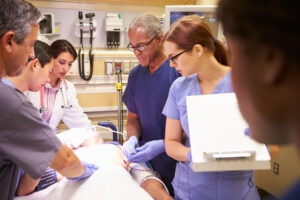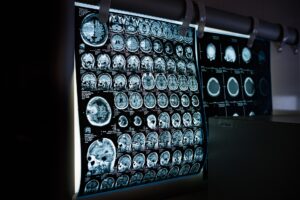There’s Good News About Treating a Bleed-Type Stroke with Today’s Medication

As strokes go, there are good things to be said about treating a bleed-type stroke with the modern medical/surgical techniques available today. By “bleed-type”, we mean a hemorrhagic stroke, one in which a blood vessel inside the brain or it’s covering layers bursts and bleeds. First, these strokes are less common than blockage-type strokes. Only 13% of strokes are from a bleeding vessel inside the head. Second, our understanding of the brain injury result from a bleed has improved tremendously during the past 20 years. Basic science research on brain cell damage after injury from this type of stroke is one source of this better understanding. Another source is better worldwide information sharing. To give an example, the first ever worldwide meeting on hemorrhagic strokes was held as recently as 2005, at the University of Michigan.
Welcome to the Neuroscience Research and Development Consultancy website. Have a question or a comment? Send it to us at: Comment@NeuroSciRandD.com
The Symptoms from Bleeding Inside the Brain or It’s Covering Layers
Here is both the good thing and the problem with symptoms of strokes. The good part is that the first obvious symptoms are the same for all strokes, whether from bleeding or from a vessel blockage. So, there’s no need to memorize new symptom checklists. They all look the same. Check out our main page on stroke for the symptoms. The problem is that no one, not even a stroke doctor, can tell the difference just by looking at the person. This point is really important. These 2 major types of stroke look the same but must be treated very differently. Because the treatments are so different, a brain CT scan is needed to see the stroke before a stroke can be treated.
One of our Montgomery, Alabama Readers Wrote to Us to Ask:
But it’s still got to be in the four hours. Right? I mean, if not even the doctors know which type of stroke it is no one can know it’s the kind of stroke where you can wait up to 72 hours. Right?
Yes, the reader is right. You might have to read the rest of the article below to understand. If someone is having a blockage-type stroke the window for the best outcome of treatment is extremely short, less than four hours. For a bleed-type stroke the time is longer, up to 72 hours. But the symptoms for all strokes are the same, so if you see someone with symptoms of a stroke you can’t know which type it is. So, you have to assume the worse, that it’s a blockage-type stroke, and call 911 immediately. Even skilled stroke physicians need an MRI scan to tell the difference, so there’s no way anyone can know just by watching the person’s symptoms.

Completely Different Treatments for the Two Types of Strokes
Here’s why we need that brain scan. A clogged blood vessel needs the medication tPA to dissolve the clot. The tPA is designed to make bleeding easier. So if the doctor gives tPA to make the blood flow more easily and the stroke is caused by bleeding, the bleeding gets worse, much worse. To treat a stroke caused by a bleeding vessel a doctor needs to repair the break in the vessel. The situations are very different, one using a medication to make blood flow easily and the other a medication to lower blood pressure and maybe surgery to stop the bleeding. The wrong choice will make the person worse, possibly with a fatal result. So, a CT scan is absolutely needed before treatment can be started. That’s why there are now ambulances that have a scanner right in the ambulance (see our page for subscribers on Mobile Stroke Units).

Also Good News: Preventing Burst Blood Vessel Type Strokes
There are things you can do to lessen the chance of having a stroke, including a burst blood vessel in the brain. They are simple things that you can do and you’ve heard them all before. A big one is to stop smoking. Another big one is to get your blood pressure checked and, if it’s high, get it treated so that it’s normal. In addition, get your blood sugar level checked and, if that’s high, you might have type-2 diabetes. See your doctor and get the medications you need to treat it. Then there the prevention tip of eating right, less unhealthy fats and less salt. It’s great that there are these things that you can change to prevent strokes. It’s great because there are things you can’t change, like your family history of stroke and any blood vessel quirks that were there when you were born.
Types of Strokes That Are Bleed-Type Strokes
There are two main types of these bleeding strokes. One type has the bleeding actually in the brain itself. In the other type the bleeding is not directly in the brain but in the coverings that surround the brain. The area of bleeding is “sandwiched” inside the covering of the brain but outside the brain itself. This bleeding outside the brain is further divided into types depending on where exactly the bleeding occurs.
Explaining a Bleeding-Type Stroke
Whether a cut on your hand or a weak blood vessel in your head, if you break the wall of a blood vessel, it bleeds. On your hand it’s simple. You apply pressure until the bleeding stops. Inside your head it’s a bigger problem. There’s no easy way to apply pressure to get it to stop. One needs a skilled physician to do it, as we explain below.
Why a Blood Vessel in Your Head Would Burst
Why would a blood vessel inside your brain burst? Because of a weak spot in the vessel wall or because of high pressure, or, more likely, a combination of the two. It’s just a burst pipe. Think of the blood vessel as a tube, like a bicycle tire inner tube. If you pump in too much air, too much pressure, it will burst, split open with a big hole. The newer the rubber and the thicker the inner tube walls, the more pressure it can hold before it bursts. The same with blood vessels. Healthy, young, elastic blood vessels do better with higher pressure. Older, stiff vessels full of cholesterol, not so much. A bit of high blood pressure and the old stiff vessel bursts and bleeds.
Transferring Blood Pressure into Brain Pressure: Not Good
If a blood vessel has high pressure inside it, and it breaks, that high pressure flows out along with a lot of blood. And, inside someone’s head there’s no place for the high pressure to be relieved. It’s high pressure in a closed box, the skull. So not only is the person losing blood into the brain (so it’s not nourishing nerve cells) but it’s building up pressure in the skull, squeezing the brain. Not good! First, doctors need to get the person’s blood pressure down, way down, fast. Then, to get the high pressure off the soft brain a surgeon might need to open a window into the skull and relieve the pressure. Then a 3rd problem creeps in. With all this happening to the brain, it gets inflamed and starts to swell, adding to the pressure. You see the dilemma.
Treating a Small Bleed-Type Stroke
Another piece of good news is that some strokes caused by vessel bleeds are small. In the Emergency Department the doctors will be able to see how bad the bleeding is. If the blood vessel breaks and the amount of bleeding is small, and if the pressure that builds up in the skull is also small, standard good medical care will be enough to treat the stroke. This care would include getting fluids in by an IV line, having the person lie still and rest, and treating any other medical problems the person has. If there are longer-term losses or problems, a course of speech therapy, and/or physical therapy, and/or occupational therapy might be necessary and would help a lot.
When The Doctor Takes a Look at How to Repair the Bleeding Blood Vessel
Some breaks in a blood vessel can be fixed without a full surgery. If the vessel can be reached by a tiny catheter, doctors can take a look and maybe fix it. The catheter, a tiny tube, can sometimes be threaded up through a major artery in an arm or leg and guided into the brain tissue, allowing a doctor to use cameras to see the problem. Once the catheter is at the place where the vessel is broken the doctor can use it to put in place a metal coil that will seal the leak and strengthen the vessel wall to prevent further bleeding.
There Are Times When Treating a Bleeding Stroke Needs a Good Surgeon
If there’s a lot of bleeding, surgery is the way to treat it. A surgeon must go in and repair the burst blood vessel and stop the bleeding. If there’s an abnormal area of the vessel that caused it to break the surgeon will need to remove that part of the vessel. Despite the comment above about opening a window in the skull to lower the pressure on the brain, if the bleeding vessel is deep in the brain, a window might not be enough. So it’s even more important for the doctors to get the blood pressure down to normal quickly. It’s also important to get into the skull just enough, that is, with a small hole, to remove the blood that has been pooling in the brain.
Urgent Treatment Needed But Less Urgent
Timing is important with treating any stroke. And though the timing to treat a bleeding stroke still needs to be fast, it’s not as urgent as with a blockage-type stroke. The “time window” is perhaps as long as 72 hours, plenty of time to realize someone is having a stroke, call an ambulance, and get him/her to the nearest Stroke Treatment Center. If the blood pressure can be brought down quickly, maybe even in the ambulance (see our page for subscribers on Mobile Stroke Units), the time window might stretch a bit to slightly more than 72 hours.
How It’s Done If the Bleeding is Deep In The Brain
One might think that if the bleeding is somewhere deep in the brain it’s an impossible problem. Not so. The surgeons have invented a way to image the head in real time and see right were the blood is pooling. They go in with just a small hole in the skull, put the tip of a long tube right in the middle of the pool of blood, and draw the blood out. This works really well and quickly lowers the pressure on the brain so the stroke victim does much better. The whole process is not quite that simple, as you might imagine, but it’s not a problem for a skilled surgeon.
But Along the Way Brain Inflammation Is A Problem
All of this activity, bleeding, high pressure, and surgery, inflame the tissues involved. The inflammation lets loose many types of substances that try to repair the damage and start the healing. Unfortunately, it’s often the case that the body overshoots and produces too much of too many substances. Too much can cause damage even as the body is trying to repair itself. There’s a protective barrier between the brain and the rest of the body, the blood-brain barrier. The barrier can be damaged by these products of inflammation, letting body substances into the brain that shouldn’t be there. This set of events can create problems that might continue for weeks. Getting the blood pressure down quickly and relieving the pressure in the head can lessen this damage caused by inflamed tissues.
Treating a Bleed-Type Stroke – The Road to Recovery
Once all the emergency and urgent medical and surgical care has been done, the path forward for the person who had the hemorrhagic stroke is rehabilitation and recovery. This path is the same for blockage and bleeding strokes. See our page on for subscribers Stroke Rehabilitation for a discussion of that part of stroke recovery.
Helpful links:
The Mayo Clinic on Hemorrhagic Stroke (halfway down the page)
American Stroke Association on Stopping the Bleeding in a Hemorrhagic Stroke
The journal Stroke on Hemorrhagic Stroke
CNS Neuroscience & Therapeutics on Hemorrhagic Stroke Mechanisms
Neurocritical Care on Deep Intracerebral Hemorrhage




